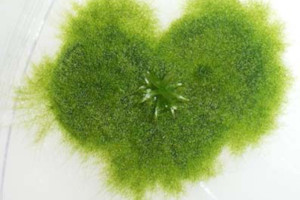Generalities
Though mosses and vascular plants have diverged for more than 400 million years, they share common genetic and physiological processes. A comparative study between representatives of these two lineages can provide insight into the evolutionary mechanisms that have led to the complex structure of modern plants. Thus, the moss Physcomitrella patens (P. patens) is used today as a model organism.
P. patens is one of the few known multicellular organisms with a high rate of homologous recombination. This property enables targeted transgenesis: insertion of an exogenous DNA sequence at a specific position in the genome. Targeted transgenesis, in addition to genetic and genomic comparative studies, provides an opportunity to elucidate the function of specific genes in the development and evolution of plants. Finally, P. patens is increasingly used in biotechnological research, to identify genes to increase crop yields or improve human health.
Reproduction
Similar to all mosses, P. patens life cycle features two alternating generations: an haploid gametophyte producing gametes and a diploid sporophyte producing haploid spores. Spores develop into a filamentous structure (protonema) made of a chloroplast rich chloroneme and a fast-growing caulonema. Protonema filamentous structure develop by growth of their apical cells and can also develop branches from their subapical cells. Instead of producing secondary branches, some of these cells may acquire the ability to produce gametophores, leafy stems anchored to the ground by rhizoids and carrying the sexual organs: the archegone (female) and antheridia (male).
P. patens is monoecious: the female and male organs are both found on the same plant. In water, sperm can swim from the antheridia to the archaegon and fertilize an oocyte. The resulting zygote produces a sporophyte that will produce thousands of spores by meiosis.
Tools
- Collection of natural or induced mutants
- cDNA, EST libraries (200,000)
- Transcriptomic, proteomic analysis
- RNAi gene silencing
- Ability to target genes by homologous recombination
- knock-out gene silencing, or knock-in insertion of reporter genes
- Bioinformatics
- Physical map for positional cloning
Databases
Infrastructures
- Institut de Biosciences et Biotechnologies d'Aix-Marseille - Laboratoire de génétique et biophysique des plantes (LGBP UMR7265 CEA-CNRS-AMU)
- http://biam.cea.fr/drf/biam/Pages/laboratoires/lgbp.aspx
- Marseille
- Institut Jean-Pierre Bourgin, UMR1318 INRAE-AgroParisTech - équipe Mécanismes de la Méiose
- https://www-ijpb.versailles.inra.fr/fr/sgap/equipes/meiose/mma.htm
- Versailles
Experts
- Fabien NOGUE
- Fabien.Nogue@versailles.inra.fr
- Institut Jean-Pierre Bourgin, Versailles,
- Benoît MENAND
- benoit.menand@univmed.fr
- Laboratoire de Génétique et Biophysique des Plantes, Marseille
Bibliography
- Articles
« Moss (Physcomitrella patens) functional genomics-Gene discovery and tool development, with implications for crop plants and human health », Ralf Reski and Wolfgang Frank, Briefings in functional genomics and proteomics, 2005
« The Physcomitrella genome reveals evolutionary insights into the conquest of land by Plants », Rensing S.A., et al., Science, 2008
« Mosses as Model Systems for the Study of Metabolism and Development », Cove D., Bezanilla M., Harries P., and Quatrano R., Annual Review of Plant Biology, 2006
« The Moss Physcomitrella patens », David Cove, Annual Review of genetics, 2005
« Physcomitrella patens: mosses enter the genomic age », Quatrano R.S., McDaniel S.F., Khandelwal A., Perroud P.F. and David J Cove D.J., Current Opinion in Plant Biology, 2007
« Exploring plant biodiversity: the Physcomitrella genome and beyond », Lang D., Zimmer AD., Rensing SA., Reski R., Trends in Plant Sciences, 2008
- Websites
